
Google’s Project Fi just keeps getting better and better. Only a few weeks ago, the company announced that it would cap how much you’ll pay for data — so if you use more than 6GB of data, you won’t have to pay for it. Now, Google is expanding the countries in which you’ll be able to use your Project Fi plan to a hefty 170.
Project Fi is known for being relatively inexpensive for those who travel a lot. While travelers will have to pay a per-minute fee for phone calls, they will still get data for the same $10 per 1GB rate, and in most countries text messages remain free. That’s a pretty sweet deal.
Notable new countries you can travel to with Project Fi include Belize and Myanmar, though a full list of countries can be found here.
Even more interesting is the fact that the Project Fi will be more forthcoming about letting you know when you’ll be covered. The app will pull information from your Gmail account — just like Google Assistant does — and it will show up with a notice telling you that you’ll be covered wherever you plan on going. The notifications will be enabled by default, but if you don’t want them to show up you can switch them off in your account settings.
In general, Project Fi is becoming a better and better choice for those who have or don’t mind buying a Project Fi-enabled phone. The company uses both the Sprint and T-Mobile networks, and hence offers pretty good coverage around the U.S. The real draw, however, is how Project Fi handles pricing. You’ll start by paying for the amount of data you think you will use. So, if you think you’ll use 2GB, you’ll pay a total of $40 — $20 for the base fee, then $10 per 1GB. If, however, you don’t use that data — say you only use 1.5GB — you’ll get reimbursed the extra $5, which can be used to pay for your next bill.
The catch is that there are only a few compatible phones. Apart from a few exceptions, you’re largely limited to phones built by Google — like Pixel or Nexus phones — though the Lenovo Moto X4 is also now included on the list.
Editors' Recommendations
- A new Google Pixel Tablet is coming, but it’s not what you think
- Google just released the first Android 15 beta. Here’s what’s new
- Check your Google Pixel Watch right now for two new features
- Your Google Pixel 8 is getting this cool missing feature after all
- Google Pixel 9: news, rumored price, release date, and more

